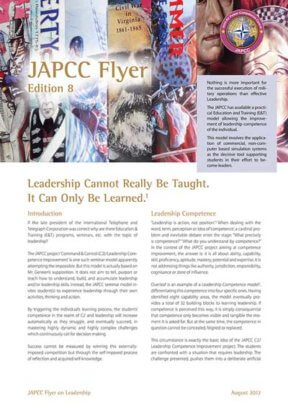Introduction
If the late president of the International Telephone and Telegraph Corporation was correct why are there Education & Training (E&T) programs, seminars, etc. with the topic of leadership?
The JAPCC project ‘Command & Control (C2) / Leadership Competence Improvement’ is one such seminar model apparently attempting the impossible. But this model is actually based on Mr. Geneen’s supposition. It does not aim to tell, purport or teach how to understand, build, and accumulate leadership and / or leadership skills. Instead, the JAPCC seminar model invites student(s) to experience leadership through their own activities, thinking and action.
By triggering the individual’s learning process, the students’ competence in the realm of C2 and leadership will increase automatically as they struggle, and eventually succeed, in mastering highly dynamic and highly complex challenges which continuously call for decision making.
Success cannot be measured by winning this externally-imposed competition but through the self-imposed process of reflection and acquired self-knowledge.
Leadership Competence
“Leadership is action, not position.“2 When dealing with the word, term, perception or idea of ‘competence’, a cardinal problem and inevitable debate enter the stage: “What precisely is competence?” “What do you understand by competence?” In the context of the JAPCC project aiming at competence improvement, the answer is: it is all about ability, capability, skill, proficiency, aptitude, mastery, potential and expertise. It is not addressing things like authority, jurisdiction, responsibility, cognisance or zone of influence.
Overleaf is an example of a Leadership Competence model3, differentiating this competence into four specific ones. Having identified eight capability areas, the model eventually provides a total of 32 building blocks to learning leadership. If competence is perceived this way, it is simply consequential that competence only becomes visible and tangible the moment it is asked for. But at the same time, the competence in question cannot be concealed, feigned or replaced.
This circumstance is exactly the basic idea of the JAPCC C2 / Leadership Competence Improvement project. The students are confronted with a situation that requires leadership. The challenge presented, pushes them into a deliberate artificial micro-cosm which has to be apprehended, comprehended and experienced. The students are assigned the roles of decision-makers and are continuously confronted with the effects and consequences of their thinking and action.
The Arena
A non-trivial situation and environment in combination with interconnected mechanisms ensuring alterations, shifting and variance, asking for C2 and leadership is not available for free.
A leadership learning platform solely based on real operations is out of the question. As live exercises are definitely horrendous resource grinders with a high impact on the involved real environment, simulation systems build the key and main stage for all efforts of inviting the students to learn leadership.
Surprising to many people, ‘Simulation’ is not a spawn of computer technology. In fact, the idea of simulation and the resulting simulation systems are as old as human civilizations. Computer-based simulation systems appear quite powerful regarding capacity, processing speed, display options, networking, and assuming the role of active protagonists within the system they run. But, there are some drawbacks.
Feasible computer-based systems are expensive to hire and use. The adaptation and change of such systems to satisfy new requirements are very expensive (in all dimensions of this word). Most important is the fact that all computer-based ‘products’ are working on context-free algorithms, i.e. programmed procedures. The human factor is at the most ‘simulated’, i.e. again programmed. This creates the perception of the black box and all players dealing with such systems tend to ‘cheat the system’ instead of exercising. Therefore, the JAPCC E&T model resorts to non-computer based simulation systems. These systems, or Conflict Simulation games (CoSim), are available on the commercial market. Their monetary price is ridiculously low. Modifying them is also ridiculously low cost.
Such a CoSim, as it is purposefully selected in accordance with the deliberately chosen set of building blocks of leadership competence, provides a truly challenging platform, or arena, for the students of leadership. There is nothing covert in those systems. Success and failure are clearly defined and both are possible final results. The active involvement of all players ensures the continuous inclusion of the human factor. There is no escaping this involvement.
‘Lessons Learned by the Individual’
Experience tells that once the students conquered their prejudices (“You expect me to roll dice instead of pressing keys, and studying paper maps and moving cardboard counters instead of looking at screens and monitors?”), they become highly involved in the micro-cosm they were pushed into. They quickly recognize the challenges offered. It is not to fulfil any hidden agenda and / or standard solution. It is the chance to experience how their ideas and decisions effect events. The students are continuously confronted with new challenges based on their responses. The CoSim shows the students their achievements quite plainly as they move closer to victory or defeat. The students’ thinking and action in the CoSim arena reflects their efforts in the realm of C2 and leadership.
During the process of playing the CoSim, it is the task of the ‘teachers’ to become observers and provide continuous feedback to the students. The ‘teachers’ are also moderators orchestrating the self-imposed process of reflection and acquired self-knowledge of the students.
Living the role of observer and moderator provide the prerequisites to give students the opportunity to improve their leadership competence.











